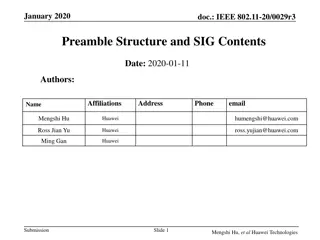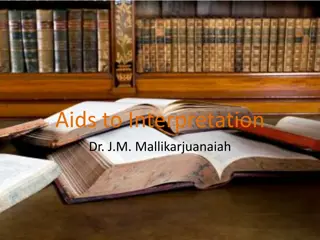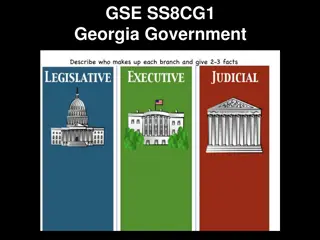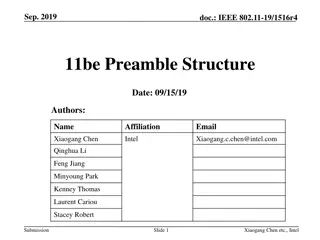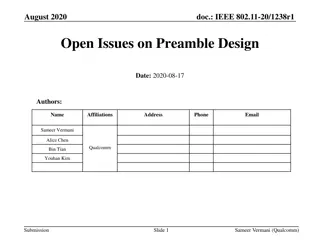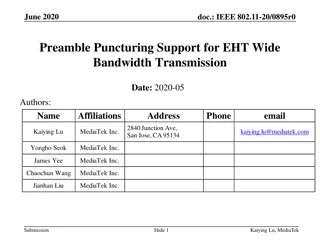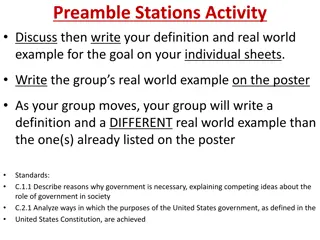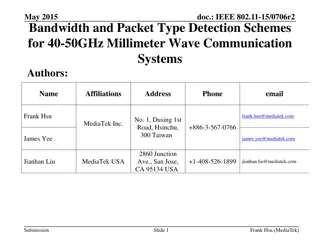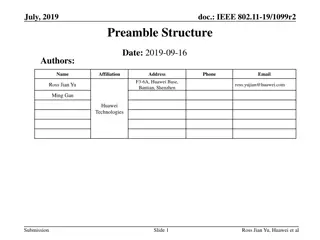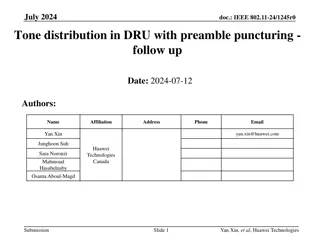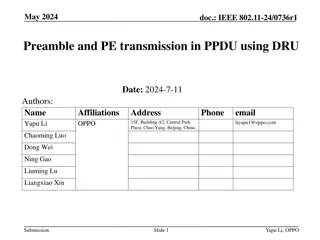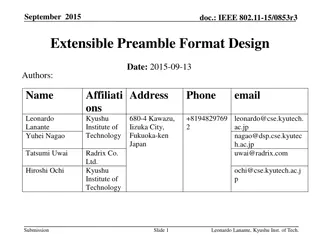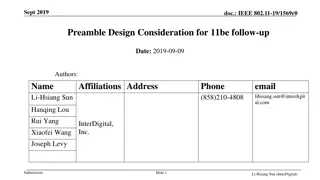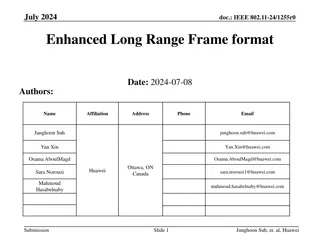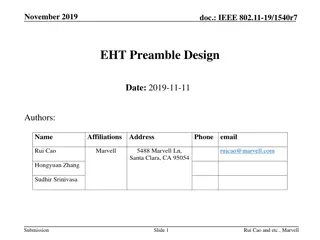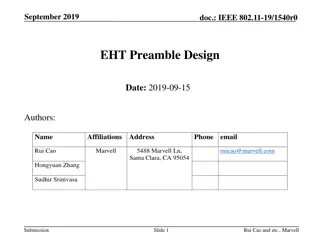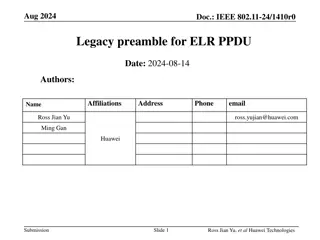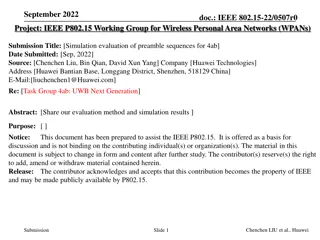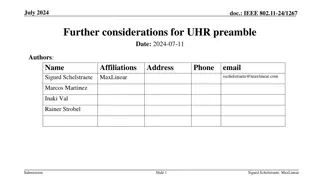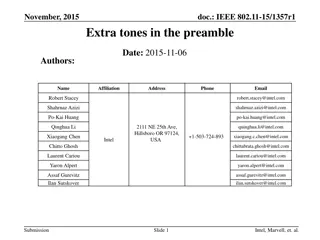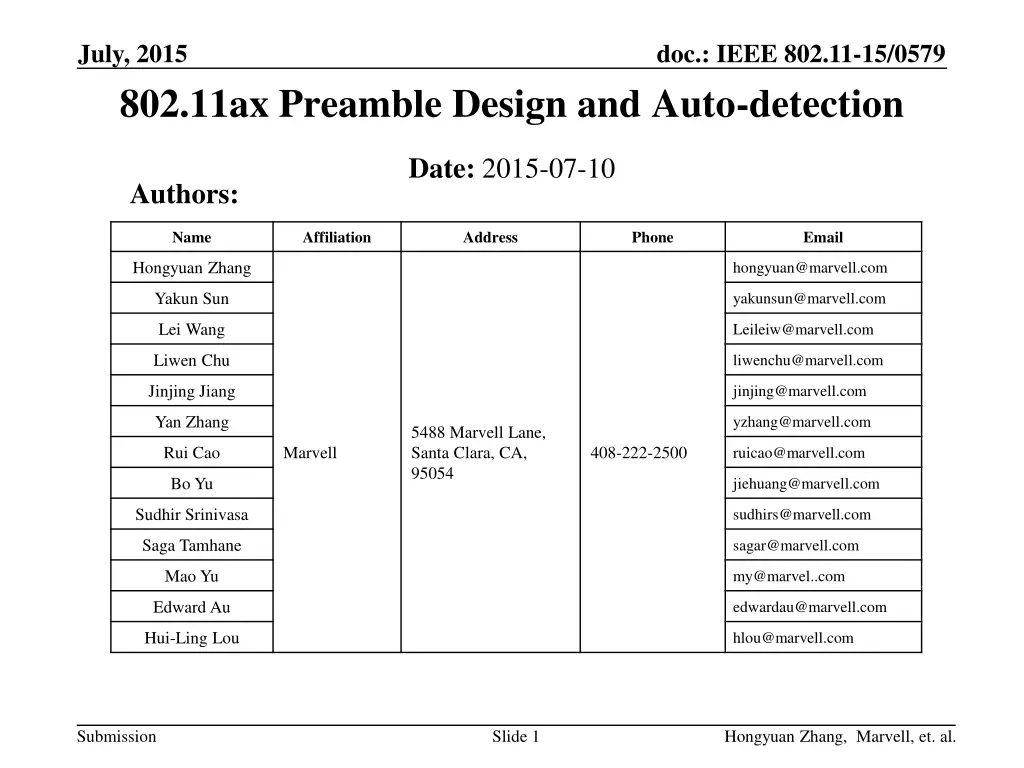
IEEE 802.11ax Preamble Design and Auto-Detection Insights
Uncover the details of IEEE 802.11ax preamble design and auto-detection from the July 2015 document authored by experts from Marvell, Qualcomm, Intel, and Broadcom. The document discusses the involved authors, their affiliations, addresses, and contact information, shedding light on the technical aspects of this crucial subject matter.
Download Presentation

Please find below an Image/Link to download the presentation.
The content on the website is provided AS IS for your information and personal use only. It may not be sold, licensed, or shared on other websites without obtaining consent from the author. If you encounter any issues during the download, it is possible that the publisher has removed the file from their server.
You are allowed to download the files provided on this website for personal or commercial use, subject to the condition that they are used lawfully. All files are the property of their respective owners.
The content on the website is provided AS IS for your information and personal use only. It may not be sold, licensed, or shared on other websites without obtaining consent from the author.
E N D
Presentation Transcript
July, 2015 doc.: IEEE 802.11-15/0579 802.11ax Preamble Design and Auto-detection Date: 2015-07-10 Authors: Name Affiliation Address Phone Email Hongyuan Zhang hongyuan@marvell.com Yakun Sun yakunsun@marvell.com Lei Wang Leileiw@marvell.com Liwen Chu liwenchu@marvell.com Jinjing Jiang jinjing@marvell.com Yan Zhang yzhang@marvell.com 5488 Marvell Lane, Santa Clara, CA, 95054 Rui Cao Marvell 408-222-2500 ruicao@marvell.com Bo Yu jiehuang@marvell.com Sudhir Srinivasa sudhirs@marvell.com Saga Tamhane sagar@marvell.com Mao Yu my@marvel..com Edward Au edwardau@marvell.com Hui-Ling Lou hlou@marvell.com Submission Slide 1 Hongyuan Zhang, Marvell, et. al.
July, 2015 Authors (continued) doc.: IEEE 802.11-15/0579 Name Affiliation Address Phone Email Straatweg 66-S Breukelen, 3621 BR Netherlands 5775 Morehouse Dr. San Diego, CA, USA 5775 Morehouse Dr. San Diego, CA, USA 5775 Morehouse Dr. San Diego, CA, USA 1700 Technology Drive San Jose, CA 95110, USA 5775 Morehouse Dr. San Diego, CA, USA 5775 Morehouse Dr. San Diego, CA, USA 5775 Morehouse Dr. San Diego, CA, USA Straatweg 66-S Breukelen, 3621 BR Netherlands Straatweg 66-S Breukelen, 3621 BR Netherlands 1700 Technology Drive San Jose, CA 95110, USA 5775 Morehouse Dr. San Diego, CA, USA 5775 Morehouse Dr. San Diego, CA, USA 1700 Technology Drive San Jose, CA 95110, USA 1700 Technology Drive San Jose, CA 95110, USA 1700 Technology Drive San Jose, CA 95110, USA Albert Van Zelst allert@qti.qualcomm.com Alfred Asterjadhi aasterja@qti.qualcomm.com Arjun Bharadwaj arjunb@qti.qualcomm.com Bin Tian btian@qti.qualcomm.com Carlos Aldana caldana@qca.qualcomm.com George Cherian gcherian@qti.qualcomm.com Gwendolyn Barriac gbarriac@qti.qualcomm.com Hemanth Sampath hsampath@qti.qualcomm.com Qualcomm Menzo Wentink mwentink@qti.qualcomm.com Richard Van Nee rvannee@qti.qualcomm.com Rolf De Vegt rolfv@qca.qualcomm.com Sameer Vermani svverman@qti.qualcomm.com Simone Merlin smerlin@qti.qualcomm.com Tevfik Yucek tyucek@qca.qualcomm.com VK Jones vkjones@qca.qualcomm.com Youhan Kim youhank@qca.qualcomm.com Submission Hongyuan Zhang, Marvell, et. al. Slide 2
July, 2015 Authors (continued) doc.: IEEE 802.11-15/0579 Name Affiliation Address Phone Email Robert Stacey robert.stacey@intel.com Eldad Perahia eldad.perahia@intel.com Shahrnaz Azizi shahrnaz.azizi@intel.com 2111 NE 25th Ave, Hillsboro OR 97124, USA Po-Kai Huang po-kai.huang@intel.com +1-503-724-893 Qinghua Li Intel quinghua.li@intel.com Xiaogang Chen xiaogang.c.chen@intel.com Chitto Ghosh chittabrata.ghosh@intel.com Laurent cariou laurent.cariou@intel.com Rongzhen Yang rongzhen.yang@intel.com Ron Porat rporat@broadcom.com Matthew Fischer Sriram Venkateswaran Andrew Blanksby Matthias Korb mfischer@broadcom.com Broadcom Tu Nguyen Vinko Erceg Submission Hongyuan Zhang, Marvell, et. al. Slide 3
July, 2015 Authors (continued) doc.: IEEE 802.11-15/0579 Name Affiliation Address Phone Email No. 1 Dusing 1st Road, Hsinchu, Taiwan James Yee +886-3-567-0766 james.yee@mediatek.com Alan Jauh alan.jauh@mediatek.com chinghwa.yu@mediatek.co m frank.hsu@mediatek.com Mediatek Chingwa Hu Frank Hsu 2860 Junction Ave, San Jose, CA 95134, USA Thomas Pare +1-408-526-1899 thomas.pare@mediatek.com chaochun.wang@mediatek.c om james.wang@mediatek.com ChaoChun Wang James Wang Mediatek USA Jianhan Liu Jianhan.Liu@mediatek.com Tianyu Wu tianyu.wu@mediatek.com russell.huang@mediatek.co m joonsuk@apple.com Russell Huang Joonsuk Kim mujtaba@apple.com Aon Mujtaba Guoqing Li Apple guoqing_li@apple.com Eric Wong ericwong@apple.com Chris Hartman chartman@apple.com Submission Hongyuan Zhang, Marvell, et. al. Slide 4
July, 2015 Authors (continued) doc.: IEEE 802.11-15/0579 Name Affiliation Address Phone Email pbarber@broadbandmobilete ch.com peterloc@iwirelesstech.com Phillip Barber The Lone Star State, TX Peter Loc F1-17, Huawei Base, Bantian, Shenzhen 5B-N8, No.2222 Xinjinqiao Road, Pudong, Shanghai F1-17, Huawei Base, Bantian, Shenzhen 5B-N8, No.2222 Xinjinqiao Road, Pudong, Shanghai 5B-N8, No.2222 Xinjinqiao Road, Pudong, Shanghai 10180 Telesis Court, Suite 365, San Diego, CA 92121 NA 303 Terry Fox, Suite 400 Kanata, Ottawa, Canada F1-17, Huawei Base, Bantian, Shenzhen 10180 Telesis Court, Suite 365, San Diego, CA 92121 NA F1-17, Huawei Base, Bantian, SHenzhen 303 Terry Fox, Suite 400 Kanata, Ottawa, Canada 5B-N8, No.2222 Xinjinqiao Road, Pudong, Shanghai Le Liu liule@huawei.com +86-18601656691 Jun Luo jun.l@huawei.com Yi Luo Roy.luoyi@huawei.com +86-18665891036 Yingpei Lin linyingpei@huawei.com Jiyong Pang pangjiyong@huawei.com Huawei Zhigang Rong zhigang.rong@huawei.com Rob Sun Rob.Sun@huawei.com David X. Yang david.yangxun@huawei.com Yunsong Yang yangyunsong@huawei.com Zhou Lan Lanzhou1@huawei.com +86-18565826350 Junghoon Suh Junghoon.Suh@huawei.com Jiayin Zhang zhangjiayin@huawei.com +86-18601656691 Submission Hongyuan Zhang, Marvell, et. al. Slide 5
July, 2015 Authors (continued) doc.: IEEE 802.11-15/0579 Name Affiliation Address Phone Email Hyeyoung Choi hy0117.choi@lge.com Kiseon Ryu kiseon.ryu@lge.com Jinyoung Chun jiny.chun@lge.com Jinsoo Choi js.choi@lge.com 19, Yangjae-daero 11gil, Seocho-gu, Seoul 137- 130, Korea Jeongki Kim jeongki.kim@lge.com LG Electronics Giwon Park giwon.park@lge.com Dongguk Lim dongguk.lim@lge.com Suhwook Kim suhwook.kim@lge.com Eunsung Park esung.park@lge.com HanGyu Cho hg.cho@lge.com Thomas Derham Orange thomas.derham@orange.com #9 Wuxingduan, Xifeng Rd., Xi'an, China Bo Sun sun.bo1@zte.com.cn Kaiying Lv Yonggang Fang Ke Yao Weimin Xing Brian Hart Pooya Monajemi lv.kaiying@zte.com.cn yfang@ztetx.com yao.ke5@zte.com.cn xing.weimin@zte.com.cn brianh@cisco.com pmonajem@cisco.com ZTE 170 W Tasman Dr, San Jose, CA 95134 Cisco Systems Submission Hongyuan Zhang, Marvell, et. al. Slide 6
July, 2015 Authors (continued) doc.: IEEE 802.11-15/0579 Name Affiliation Address Innovation Park, Cambridge CB4 0DS (U.K.) Maetan 3-dong; Yongtong-Gu Suwon; South Korea 1301, E. Lookout Dr, Richardson TX 75070 Innovation Park, Cambridge CB4 0DS (U.K.) 1301, E. Lookout Dr, Richardson TX 75070 Maetan 3-dong; Yongtong-Gu Suwon; South Korea Phone Email Fei Tong f.tong@samsung.com +44 1223 434633 Hyunjeong Kang hyunjeong.kang@samsung.com +82-31-279-9028 Kaushik Josiam k.josiam@samsung.com (972) 761 7437 Samsung Mark Rison m.rison@samsung.com +44 1223 434600 Rakesh Taori rakesh.taori@samsung.com (972) 761 7470 Sanghyun Chang s29.chang@samsung.com +82-10-8864-1751 Yasushi Takatori takatori.yasushi@lab.ntt.co.jp Yasuhiko Inoue inoue.yasuhiko@lab.ntt.co.jp 1-1 Hikari-no-oka, Yokosuka, Kanagawa 239-0847 Japan Yusuke Asai NTT asai.yusuke@lab.ntt.co.jp Koichi Ishihara ishihara.koichi@lab.ntt.co.jp Akira Kishida kishida.akira@lab.ntt.co.jp 3-6, Hikarinooka, Yokosuka- shi, Kanagawa, 239-8536, Japan Akira Yamada yamadaakira@nttdocomo.com watanabe@docomoinnovations. com hpapadopoulos@docomoinnova tions.com Fujio Watanabe NTT DOCOMO 3240 Hillview Ave, Palo Alto, CA 94304 Haralabos Papadopoulos Submission Hongyuan Zhang, Marvell, et. al. Slide 7
July, 2015 doc.: IEEE 802.11-15/0579 Introduction Background Based 802.11ax SFD [1]: An HE PPDU shall include the legacy preamble (L-STF, L-LTF and L-SIG), duplicated on each 20 MHz, for backward compatibility with legacy devices. HE-SIG-A and HE-SIG-B fields are included LSTF 8us LLTF 8us LSIG 4us HE Data Payload (4x Symbol Duration (GI+12.8us) HE-Preamble Legacy Preamble Highlights of this contribution Focus on the 11ax packet autodetection design; Propose an LSIG repetition based 11ax packet autodetection scheme. Submission Slide 8 Hongyuan Zhang, Marvell, et. al.
July, 2015 doc.: IEEE 802.11-15/0579 Desired Attributes of 11ax Preamble Design for 11ax Packet Autodetection Robust autodetection: Backward compatible, allowing legacy spoofing High reliability in Very low false triggers Dense deployments with high interference All 11ax channels of interests, including outdoor UMI channels. Early autodetection: Differentiate from 11a/n/ac packets as early as possible, to reduce the number of different hypotheses at the receiver. Simple and unified design Submission Slide 9 Hongyuan Zhang, Marvell, et. al.
July, 2015 doc.: IEEE 802.11-15/0579 Existing 802.11 OFDM Packet Classifications Auto-detection based on QBPSK Detection BPSK QBPSK LLTF (8 usec) LSIG (4 usec) LSTF (8 usec) 11a Data LLTF (8 usec) LSIG (4 usec) LSTF (8 usec) HT- SIG1 HT- SIG2 11n-MM HT-LTF1 (8 usec) HT-STF (8 usec) HT- SIG1 HT- SIG2 11n-GF VHT- SIGA1 VHT- SIGA2 LLTF (8 usec) LSIG (4 usec) LSTF (8 usec) 11ac LLTF (8 usec) LSIG (4 usec) LSTF (8 usec) ? 11ax Submission Slide 10 Hongyuan Zhang, Marvell, et. al.
July, 2015 doc.: IEEE 802.11-15/0579 Proposed 11ax Packet Format Use LSIG repetition for 11ax packet autodetection, i.e, Having a 4us symbol repeating the LSIG content, in the 11ax preamble right after the legacy section Modulating the R-LSIG (LSIG repetition ) symbol with BPSK and rate BCC. The next symbol (HE-SIGA) after RLSIG is also BPSK, legacy devices will detect the packet as 11a/g. Discussed in separate contributions BPSK GI=0.8us BPSK GI=0.8us BPSK L-STF 8us L-LTF 8us L-SIG 4us R-LSIG 4us HE- SIGA HE-SIGB (DL) HE- STF .. HE-LTFs Legacy Preamble HE-Preamble Submission Slide 11 Hongyuan Zhang, Marvell, et. al.
July, 2015 doc.: IEEE 802.11-15/0579 Example of Detection Procedure at Rx Step-1: LSIG and RLSIG repetition detection. Step-2: LSIG and RLSIG MRC, and demodulate/decode. Step-3: Content Check: e.g. Parity bit, Rate=6Mbps and L- LENGTH!=3x. When both steps 1 and 3 passes, 11ax is detected, otherwise jump back to 11a/n/ac state machine. Note that steps 2 and 3 are required as part of the packet decoding anyways (similar to 11ac)! Submission Slide 12 Hongyuan Zhang, Marvell, et. al.
July, 2015 doc.: IEEE 802.11-15/0579 Illustration of the achieved Early 11ax Detection Early 11ax detection LSIG Rep detection + LSIG Content check finishes approx at 3us after end of R-LSIG Before the potential (V)HT-STF field in 11n/ac No need to revise the old 11a/n/ac detection state-machine. In the case of repetition false trigger, receiver may still fall back to conventional 11n/ac state-machine on time (for AGC) . Submission Slide 13 Hongyuan Zhang, Marvell, et. al.
July, 2015 doc.: IEEE 802.11-15/0579 Other Benefits Reliable detection performance: miss detection is lower than the error rate of combined LSIG+RLSIG field, and with very low false detection probability. Refer to the simulation results in subsequent slides. Improve LSIG field error rate: therefore beneficial for the following cases Outdoor (UMI channel). High density low SINR. Reduce the chance of collision (more reliable CCA determination), therefore reducing the extra overhead caused by re-transmissions. Reducing LSIG false positive probability at 11ax receivers. Enabling possible range extension. Submission Slide 14 Hongyuan Zhang, Marvell, et. al.
July, 2015 doc.: IEEE 802.11-15/0579 On Detection Algorithm It is recommended to conduct the repetition detection in frequency domain (post FFT). For better performance. There are multiple ways of frequency domain repetition detection, some of which are simple and get reliable miss and false detection performances. Refer to simulation results. The LSIG content check (after combining) happens right after the repetition check, therefore serves as an additional checksum. Submission Slide 15 Hongyuan Zhang, Marvell, et. al.
July, 2015 doc.: IEEE 802.11-15/0579 Simulation Setup 20 MHz. 1/2/4Tx, and 1Rx antennas UMi-NLOS, and DNLOS channels Ensemble normalized CSD values per Antenna (2/4Tx) [0, -50, -100, -150]ns as 11ac Or [0, -50, -100, -150]*2 ns Actual 40ppm CFO and phase/CFO tracking Actual timing. Submission Slide 16 Hongyuan Zhang, Marvell, et. al.
July, 2015 doc.: IEEE 802.11-15/0579 1x1, UMI Submission Slide 17 Hongyuan Zhang, Marvell, et. al.
July, 2015 doc.: IEEE 802.11-15/0579 1x1 DNLOS Submission Slide 18 Hongyuan Zhang, Marvell, et. al.
July, 2015 doc.: IEEE 802.11-15/0579 2x1, UMI 2TX, UMi-NLOS, CFO on, Actual timing, Un-Normalized Channels 0 10 LSIG no rep, PER LSIG rep, PER Pmiss Pfalse, rep detect+content -1 10 PER/Error Rate -2 10 -3 10 -4 10 -5 0 5 10 15 20 25 SNR (dB) No false trigger happens for 2Tx + 11ac per-antenna CSD. 11ac per-ant CSD values works fine for 2Tx. Submission Slide 19 Hongyuan Zhang, Marvell, et. al.
July, 2015 doc.: IEEE 802.11-15/0579 2x1 DNLOS (Pfalse = 0) Submission Slide 20 Hongyuan Zhang, Marvell, et. al.
July, 2015 doc.: IEEE 802.11-15/0579 4x1 UMI 4TX, UMi-NLOS, CFO on, Actual timing, Un-Normalized Channels 4TX, UMi-NLOS, CFO on, Actual timing, Un-Normalized Channels 0 0 10 10 LSIG no rep, PER LSIG rep, PER Pmiss Pfalse, rep detect+content LSIG no rep, PER LSIG rep, PER Pmiss Pfalse, rep detect+content -1 -1 10 10 PER/Error Rate PER/Error Rate -2 -2 10 10 -3 -3 10 10 11ac per-antenna CSD Value 2x 11ac per-antenna CSD Value -4 -4 10 10 -5 0 5 10 15 20 25 -5 0 5 10 15 20 25 SNR (dB) SNR (dB) 2x CSD values improves detection and decoding performances. Miss and False triggering probability are still very low for both CSD values. Submission Slide 21 Hongyuan Zhang, Marvell, et. al.
July, 2015 doc.: IEEE 802.11-15/0579 v1-Updates The following comments were received when we presented v0 in May meeting: Efficiency: waste one symbol (RLSIG) solely for autodetection. False Detection probability (also discussed by [4]) Future Extend-ability: How to design future PHY amendments. Address these comments in subsequent slides. Submission Slide 22 Hongyuan Zhang, Marvell, et. al.
July, 2015 doc.: IEEE 802.11-15/0579 Benefits of RLSIG Autodetection: Early detection to reduce number of hypothesis during preamble processing. Reliable detection performance (see simulations). Outdoor Reliability, and Range Extension: As in [2][3], we prefer a unified normal SIGA design with 2 OFDM symbols, while allowing a SIGA diversity-repetition mode for range extension. In 11n/11ac, the preamble performance is limited by decoding error of VHT-SIGA. In 11ax, RLSIG & SIGA repetition in [3], enables 3~5dB or even higher improvement over 11ac preamble (depending on implementation) for SU. Considering 11ac data portion (e.g. MCS0, 20MHz, 32bytes), or 11ax by applying more advanced Tx/Rx implementations (e.g. STF/LTF Boost [3]), the gap could be even larger. See Sim results in subsequent slides Benefit outdoor and indoor range extension (e.g. for IoT applications), for both 2.4GHz and 5GHz. Submission Slide 23 Hongyuan Zhang, Marvell, et. al.
July, 2015 doc.: IEEE 802.11-15/0579 Results-1 UMI-1x1 >5dB Gap @ 1% PER Submission Slide 24 Hongyuan Zhang, Marvell, et. al.
July, 2015 doc.: IEEE 802.11-15/0579 Results-2 DNLOS-1x1 ~3dB Gap @ 1% PER Submission Slide 25 Hongyuan Zhang, Marvell, et. al.
July, 2015 doc.: IEEE 802.11-15/0579 Results-3 UMI-4x1-11ac CSD 5dB Gap @ 10% PER Submission Slide 26 Hongyuan Zhang, Marvell, et. al.
July, 2015 doc.: IEEE 802.11-15/0579 Results-4 UMI-4x1- 2 x 11ac CSD 4dB Gap @ 10% PER Submission Slide 27 Hongyuan Zhang, Marvell, et. al.
July, 2015 doc.: IEEE 802.11-15/0579 False Detection (1) 11ax classification will detect the repetition of LSIG/RLSIG, and then check content. A potential 11a packet may cause false triggering if: Combined LSIG can pass 11ax content check; Rate Rsvd LENGTH Parity Tail 1101 0 Even parity 000000 32~2304 Bytes, and not divided by 3 A legitimate first 11a data symbol as below and scrambled by one out of 127 scrambler seed; Protocol Version Service (16bits) Type Subtype 0x0 00 00/01/10 0000~1111 LSIG and the first data symbols needs to be alike to pass repetition check. Submission Slide 28 Hongyuan Zhang, Marvell, et. al.
July, 2015 doc.: IEEE 802.11-15/0579 False Detection (2) How Alike 11a LSIG and 1st Data Symbol Are? Check the Hamming distance of coded bits for a pair of 11ax-content-consistent LSIG symbols and 11a first data symbols. The smaller distance, the larger probability of passing repetition check. 47 = th where , are the coded SIG/Data bits Hamming D s d s d i i i i i = 0 i Look at the distribution of Hamming distances between all pairs of LSIG and data symbol (~3 million cases). Minimal Hamming distance of 5 10^-4 @ HD=10. Probability of Hamming distance no larger than 8 (more than 20% of identical bits) is about 2x10-5 already a very low probability of two symbols alike. We applied a rep detection with a constant threshold corresponding to Hamming distance of 8 at high SNR, so the false trigger at very high SNR is only 2x10-5even without content check. 0 0 10 10 -1 -1 10 10 -2 -2 10 10 P(Distance x) -3 -3 10 10 PDF -4 -4 10 10 -5 -5 10 10 -6 -6 10 10 -7 -7 10 10 0 5 10 15 20 25 30 35 40 45 0 5 10 15 20 25 30 D (Hamming Distance) D (Hamming Distance) Submission Slide 29 Hongyuan Zhang, Marvell, et. al.
July, 2015 doc.: IEEE 802.11-15/0579 False Detection (3) Similarly, to check We did another brute force check for 11ac LSIG+VHTSIGA1: LSIG: 6Mbps, L-LENGTH%3=0 VHTSIG-A-1: SU with GID=0 or 63, MU with legitimate Nsts fields (each Nsts <=4, all Nsts sum <=8). Minimal HD is 9, much larger than 11a, a threshold equivalent to HD=8 will lead to zero Pfalse at high SNR. Or equivalently 10^-4 @ HD=12. Therefore the 11ac false detection to 11ax as mentioned in [4] won t be an issue Slide 30 Submission Hongyuan Zhang, Marvell, et. al.
July, 2015 doc.: IEEE 802.11-15/0579 Future Extend-ability Future PHYs are highly dependent on the scope of the future PARs. Example-1: For a higher throughput PAR, we may design preamble on top of 11ac. Example-2: For a longer range PAR, we may redesign a new long range preamble. Even assuming we need another high efficiency & outdoor PAR similar to 11ax in the future, the current autodetection method is still very extendable. Example: in the future amendment, RLSIG may be scrambled by a known sequence on the data tones, while this sequence has a very large hamming distance (HD) from the 11ax RLSIG. Negligible false detection as 11ax (by using large HD design). Negligible increase on false detection as legacy 11a/n/ac. Submission Slide 31 Hongyuan Zhang, Marvell, et. al.
July, 2015 doc.: IEEE 802.11-15/0579 Conclusions We propose to repeat LSIG field and use it as the 11ax autodetection mechanism. By simulations, this method shows reliable miss detection and false detection performances in both indoor and outdoor channels. It realizes early 11ax detection, enabling simple and clean receiver design state-machine. It improves the LSIG performance for outdoor and highly dense deployments enables range extension. Future extend-ability is not an issue. Submission Slide 32 Hongyuan Zhang, Marvell, et. al.
July, 2015 doc.: IEEE 802.11-15/0579 Straw Poll #1 Do you support to add to the SFD as below: 11ax preamble shall have a 4us symbol repeating the L-SIG content, right after the legacy section? This symbol shall be modulated by BPSK and rate BCC. BPSK GI=0.8us BPSK GI=0.8us LSIG R- LSIG HE-SIGA Symbols Submission Slide 33 Hongyuan Zhang, Marvell, et. al.
July, 2015 doc.: IEEE 802.11-15/0579 Straw Poll #2 Do you agree to add the following into the SFD: In an HE PPDU, both the first and second OFDM symbols immediately following the L-SIG shall use BPSK modulation. NOTE This is to spoof all legacy (11a/n/ac) devices to treat an HE PPDU as a non-HT PPDU. Submission Slide 34 Hongyuan Zhang, Marvell, et. al.
July, 2015 doc.: IEEE 802.11-15/0579 References [1] 11-15-0132-02-00ax-spec-framework [2] 11-15-0822-00-00ax-SIG-A Structure in 11ax Preamble (Jianhan Liu, et al) [3] 11-15-0826-00-00ac- HE-SIG-A transmission for range extension (Jiayin Zhang, et al) [4] 11-15-0823-00-00ax-preamble-design-and-auto-detection-for-11ax Submission Slide 35 Hongyuan Zhang, Marvell, et. al.

